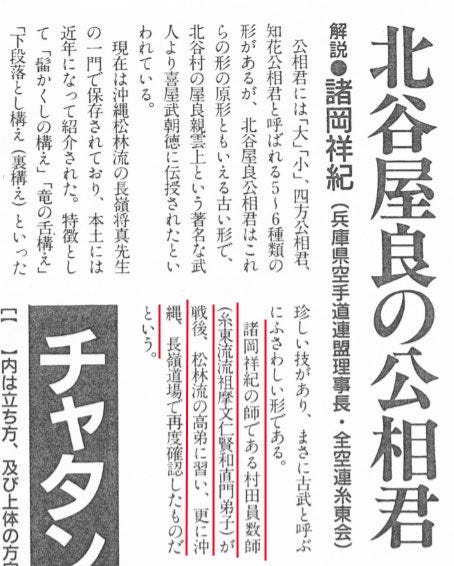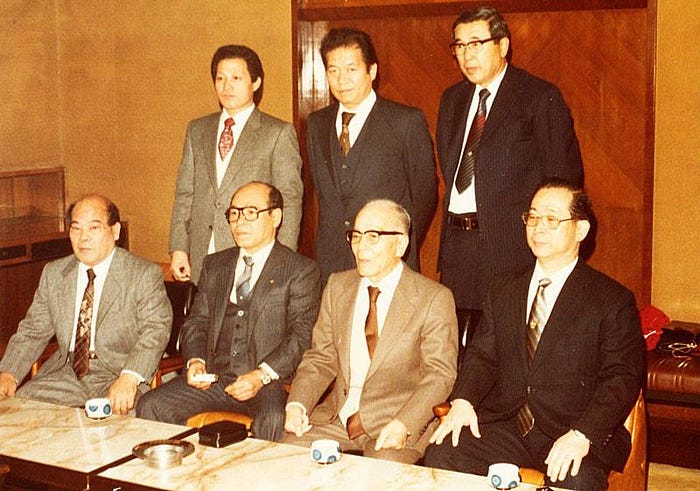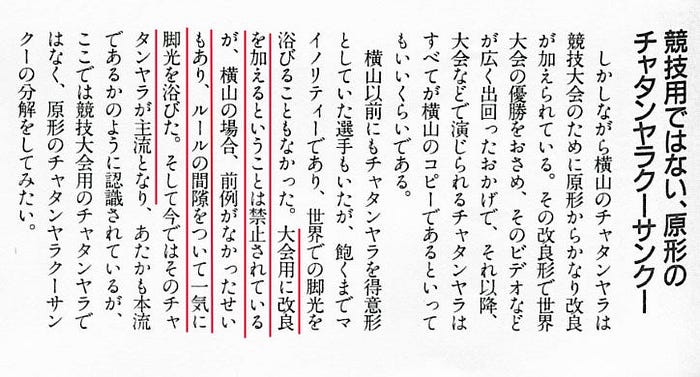Earlier, I wrote an article on “Matsumura Rōhai.” In that article, I wrote that Matsumura Rōhai of Shitō-ryū, which is also designated as the second designated kata by the All Japan Karate-dō Federation, is actually the kata “Rōhai” of Okinawa’s Matsubayashi-ryū, which was learned by karate practitioners in the Kansai region after World War II and introduced to the Japanese mainland. This is because Matsumura Rōhai is not mentioned in Mabuni Kenwa’s prewar writings.
Furthermore, some foreign karate researchers have suggested that Tomari Bassai and Matsukaze of Shitō-ryū may have been plagiarized from Passai and Wankan of Matsubayashi-ryū, respectively. However, while it is highly likely based on circumstantial evidence that these kata were plagiarized, it is difficult to definitively prove it from historical sources. However, there is one exception: the kata known as Chatan Yara Kūsankū of Shitō-ryū.
In fact, there was an article on this subject in “Monthly Karate-dō.”

According to the article, Murata Kazutoshi, master of Moro’oka Yoshinori of the Shitō-kai, learned it from one of the top students of Matsubayashi-ryū, and later confirmed it again at the dōjō of Nagamine Shōshin (founder of Matsubayashi-ryū) in Okinawa.
It is unclear from the article who the top student of the Matsubayashi-ryū was, but it may have been Yara Chōi, the sōke of Matsumora-ryū in Osaka. This is because Mr. Yara was a Shihan (master instructor) of the Nagamine Dōjō in Okinawa for a period of time after World War II, and after moving to Osaka, he called his dōjō a branch of Matsubayashi-ryū for a while.
The sōke (Motobu Chōsei) was acquainted with Mr. Yara, and his friend Fukuhara Chōsei was a student of Mr. Yara. I knew these people well because I also attended the Fukuhara Dōjō when I was in elementary school.

Or it could have been another Matsubayashi-ryū karate practitioner other than Mr. Yara. However, I believe that there may have been more than one route by which Chatan Yara Kūsankū was introduced to the mainland, since not only Murata Kazutoshi but also several Shitō-ryū people, including Hayashi Teruo (founder of Hayashi-ha Shitō-ryū), went to Okinawa to study at the Nagamine Dōjō.
For example, the late Inoue Yoshimi (Inoue-ha Shitō-ryū Keishin-kai) was a student of Hayashi. Many of Inoue’s students, such as Usami Rika, excelled at Chatan Yara Kūsankū.
The article mentioned above has another interesting point. It states that Chatan Yara Kūsankū on the mainland was altered for competition.


Chatan Yara Kūsakū suddenly came into the limelight in the 1990s, due to the success of Yokoyama Hisami. Yokoyama was also a student of Inoue’s, and the article states the following:
However, Yokoyama’s Chatan Yara has been considerably altered from its original form for competition. She won the world championship with this improved version, and thanks to the widespread distribution of videos of her performance, it is fair to say that all Chatan Yaras performed in competitions since then have been copies of Yokoyama’s.
Although there were other Chatan Yara performers before Yokoyama, they were in the minority and did not gain international prominence. Although it is forbidden to make modifications for competitions, in Yokoyama’s case, there was no precedent, and she quickly came into the limelight, taking advantage of a gap in the rules. And now that Chatan Yara has become mainstream. …… (Note)
It is often said that kata of the Japanese mainland have been altered for competitions, but it is rare to read such an article about the background of such alterations. Moreover, this is not a kata that was introduced before the war, but a relatively new kata that was introduced from Okinawa after the war.
So, what was the original form of Chatan Yara Kūsankū? The following video shows Chatan Yara Kūsankū of Matsubayashi-ryū in the 1960s.
Compared to Chatan Yara Kūsankū on the mainland, it is almost identical in movement, but the flavor is quite different.
Incidentally, Chatan Yara Kūsankū of the All Japan Karatedo Federation is registered as a Shito-ryū kata. Therefore, it is not possible to compete as Chatan Yara Kūsankū of Matasubayashi-ryū, or if one were to compete, it would be difficult to win.
Unfortunately, the kata of the Okinawan schools are excluded from the JKF. Therefore, if you want to win a match, you must perform the kata of the four major mainland schools.
The WKF (World Karate Federation) has recently revised its rules, but it will be a long time before Okinawan kata can be used to compete and achieve results.
Incidentally, Chatan Yara Kūsankū is originally a kata of Kyan Chōtoku, which has been passed down in other schools of the Kyan lineage besides Matsubayashi-ryū.
Note: Monthly Karate-dō, March 1999, Fukushodo, p. 39.
The original Japanese article was written on July 1, 2017 on Ameblo.
Thank you for reading my story. If you would like, please follow me.

Motobu-ryu Blog
Shihan, Motobu Kenpō 7th dan, Motobu Udundī 7th dan. Discusses the history of karate and martial arts, and introduces Japanese culture and history.
